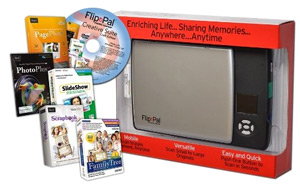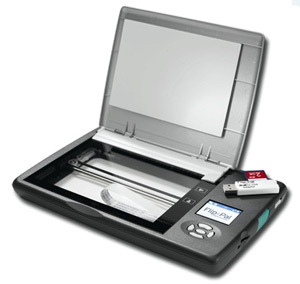I’ve been using the FlipPal Scanner for several months – and it’s made scanning a real pleasure. I got started because I kept watching Walt Grady, Diane Miller, and others demonstrate them at conferences I’ve attended over the last year or more. I bought a unit about 6 months ago. Dale and I then had a business trip in which we had to drive nearly 3000 miles. During the drive, Dale scanned thousands of my pictures – right there about 3 feet from me. We had a large box full of photos, many still in the envelopes from the processor – most 30 to 40 years old. Many I hadn’t seen since I took the pictures. In October, my brother, Steve, flew down from Washington State, bringing a suitcase full of the old family photos with him. We scanned many of them, and some we’ve still got to scan when he visits again in December.
As most of my readers know, I’ve been scanning my genealogy documents in an attempt to dispose of several dozen file boxes of full of them. I’ve been using a flatbed scanner, as well as a high-speed scanner with a feeder attached. I’ve now added my FlipPal to that mix.
The big advantage for me has been that I can scan my photos a lot faster then usual using the FlipPal. Large photos and documents can be scanned in several shots, and then stitched together perfectly using the software provided with every FlipPal. Do you want to scan photos in an album? No problem. I just scanned an album that belonged to my mother, with many of the photos glued into place. I just popped the lid off of the scanner, turned it over, laid the scanner on the picture on the album page – lined it up by looking right through the scanner – and pressed the scan button. The scanner has a little window on it where the user can check to see if the scan came out good – just like your digital camera. Scans can be made in both 300 dpi, and 600 dpi. The software supplied with the scanner is both Windows and Mac compatible.
The FlipPal is battery-operated, allowing full portability. When I made my first scans, I was using typical AA batteries that I bought in quantity at Costco. As I remember it, I was getting about 400 scans or so on a set of four batteries. I quickly realized that I was going to save huge quantities of money by purchasing an AC AA battery charger and a dozen batteries. That was a smart move. When I purchased my FlipPal, the only case available had no pockets for supplies. A deluxe case is now available – complete with pockets.
Another brand-new innovation is the FlipPal Sketch. You just lay the Sketch on photo that you wish to make notes on (like people’s names!), and scan the picture through the marked-up Sketch – thus identifying folks in the picture. I’ve been using a prototype – but the “real-thing” will shipping in late November.
Another terrific innovation is a great software collection put together on DVD for the FlipPal. I’ve been using this software on my PC running Windows 7 – and I’m very impressed. I’ve got Adobe Photoshop, as well as Photoshop Elements in my office. One program alone in this Creative Suite collection, now available packaged with the FlipPal, can do most everything that Elements does, but the entire Creative Suite adds only about half of the cost of Photoshop Elements alone – and the learning curve isn’t bad either!
By the way, the FlipPal has been approved for use not only in the Library of Congress, but in the National Archives. It’s gentle on documents, as it’s very light. And speaking of light, very little is used in the scanning process – thus protecting those precious old documents. Items that could not be photocopied, can be scanned with the FlipPal.
I was so impressed with the FlipPal that I signed up as an affiliate a couple months ago. So I now get small checks from Couragent each month. Since we sell at many conferences, and on the Internet, we recently signed up not only as a FlipPal affiliate, but as a dealer. Family Roots Publishing is now stocking FlipPals – and just in time for Christmas too! The FlipPal unit itself sells for under $150, while the FlipPal with the Creative Suite sells for under $200.
As a user myself, I highly recommend that you add on the following items when purchasing a FlipPal – either the basic unit – or with the Creative Suite (the Creative Suite software runs under Windows Vista 7, vista, or XP). Sorry, the Creative Suite software isn’t Mac compatible. Note that the FlipPal software itself is both Windows and Mac compatible.
- A Deluxe Case – Blue, Red, or Purple
- A 3-sheet pack of window protectors
- A FlipPal Sketch
- An eneloop (by Sanyo) Battery Charger with 8 AA batteries


Can this scanner do copies from old church books well?
There’s no reason why it wouldn’t. I’ve been scanning old ledgers with mine, so I’m sure it would work just fine.
I purchased flip pal scanner to get copies of microfilm reader material. Have not been able to get it to work. Also, to copy off computer screen.
Have you tried this in your research? Any hints or help to get it to work?
Thanks
I’ve not attempted to scan microfilm being projected by a microfilm reader. I have serious doubts it would work well for that purpose, and I wouldn’t recommend it for that. A good digital camera would probably work best.
I’ve been considering buying a flip scanner. I’ve read good reviews, but was wondering about the sheet protectors. No one has mentioned them. Do you use then only when storing the scanner or do you use them while scanning? and how do you clean the scanner?
I think you are most likely referring to the window protectors. It is used to add extra protection to the bottom viewing window aginst scratches. You don’t apply it to the scanner bed itself – so you never scan through it.. As for cleaning, you just wipe down the outside of the unit. Personally, I just wipe mine down regularly with a cleaning cloth that I got from iClear.com. It’s the same cloth that I use for my computer monitors – and my glasses!
I am trying to convince myself to order the Flip Scanner. Adding the identification of the photos is very important to me as I realized that most likely the next generation would not know this information. Not much has been written about the Flip Pal SKETCH. Does this Sketch allow identification without having to scan the picture twice? I’m anxious to get started… but I hesitate…..
You do have to scan the picture twice – which takes an extra 20 seconds. I’ve not found it to be an issue. We’ve been swamped with puchasers for both the Sketch and the Flip-Pal scanner itself at RootsTech 2012 (going on now). You might want to read my blog of January 9. See: http://www.genealogyblog.com/?p=16366
Was wondering if the scanner can be used with an a/c adapter when not using it with batteries? Also, the “Sketch” will not be available until November???? Thanks for your response.
No AC adapter… I use rechargeable batteries. That post was written last year (October), thus the November date. The sketch has been available for 5 or 6 months. We ship them every day.
Are there full instructions with it and how to transfer the photos to the computer? Is it compatible with a i5-750 Processor with Windows 7 Home Edition? A warranty perhaps? What are your return and reimbursement policies if I can’t get it to work for me? Wish someone would post their results after using one. Thank you for your reply.
Yes – extensive instructions come with it – all residing on the SD-card. There is also more instruction available online at Flip-Pal.com. The software runs fine under all relatively current versions of Windows. It has a one-year warranty, and has a 30 – day money back guarantee. See: http://flip-pal.com/customer-care/
Hi Leland,
I am looking for a scanner like this one. I like the portability, but I need it to scan microfilm. Are you aware of any such scanners?
Thanks.
Michelle
Michelle,
Scanning microfilm is a problem for most small scanners. I have one that was produced a good decade ago, but is no longer available. At the moment, I don’t know of any… Sorry…
Leland